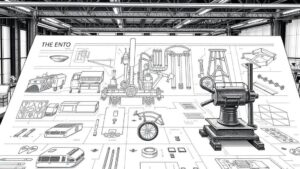Mapping Forgotten Pioneer Blacksmith Shops for Lost Tool Discoveries
Mapping Forgotten Pioneer Blacksmith Shops for Lost Tool Discoveries
The history of blacksmithing in America is vast, yet many contributions made by pioneer blacksmiths remain unrecognized. This research article aims to explore the forgotten blacksmith shops that were hubs of tool-making during the pioneer era, particularly from the late 18th century through the mid-19th century. By mapping these erstwhile establishments, this study seeks to uncover lost tools and their historical significance, providing a deeper understanding of the blacksmiths role in early American economy and culture.
The Historical Context of Pioneer Blacksmithing
Blacksmithing played a crucial role in the development of early American society, functioning as a cornerstone for agricultural and frontier life. Blacksmiths not only crafted essential tools necessary for farming but also served as community repair shops and social gathering points. Between 1790 and 1860, there were approximately 100,000 blacksmiths in the United States, reflecting the burgeoning demand for metal tools and goods.
For example, in the mid-1800s, Ohio was home to over 1,700 blacksmiths, many of whom specialized in creating tools such as plows, hoes, and horseshoes. The craftsmanship involved was significant; a well-made tool could last a lifetime or be passed down through generations. Given this importance, it is surprising how many blacksmith shops have been forgotten. The historical maps of pioneer settlements often lack specific details regarding these traditional crafts, which contributes to the loss of valuable archeological insights.
Methodology for Mapping Blacksmith Shops
The methodology for mapping forgotten blacksmith shops involves a multi-faceted approach that integrates historical research, cartographic technologies, and field surveys. The following steps are crucial in accurately identifying and documenting these sites:
- Archival Research: This includes studying historical records, municipal archives, and land deeds from county courthouses. Such documents often contain references to blacksmith shops, including names, locations, and dates of operation.
- Oral Histories: Engaging with local communities to gather oral histories can reveal information about blacksmith shops that may not have been documented. Interviews with historians and long-time residents can provide insights regarding tools that were made and their significance.
- Geographic Information Systems (GIS): Utilizing GIS technology allows researchers to create detailed maps that visually represent the locations of blacksmith shops. These maps can be layered with historical data to show changes over time.
Case Studies: Locations and Tool Discoveries
Several case studies highlight the efficacy of this mapping effort. For example, in the small town of New Hope, Pennsylvania, researchers identified a blacksmith shop dating back to 1824 based on land records. Excavations revealed a cache of tools, including two wrought-iron hand tools–a sickle and a hoe–both pivotal for early agricultural practices. Studies show that tool recovery from historic sites can shed light on the material culture of the time and the technological advances made in the blacksmithing trade.
Another notable example occurred in Virginia where researchers unearthed remnants of a blacksmith shop believed to have operated from 1840 to 1870. Notably, they found a complete anvil and tongs, alongside fragments of nails and horseshoes. According to the Virginia Department of Historic Resources, the presence of these used tools illustrates the prevalent agrarian society and the reliance on blacksmith services during this era.
The Significance of Recovering Lost Tools
Recovering lost tools from these sites is not merely an act of archaeology; it carries substantial historical significance. The tools serve as tangible evidence of the technological advancements and craftsmanship that supported American pioneering life. As stated by historian Dr. Edward P. Smith, “The recovery of tools from blacksmith shops allows us to create a dialogue between past and present, highlighting how innovation and artistry shaped daily life.”
Plus, recovered tools can contribute to museums’ collections, thereby enhancing public understanding of this overlooked industry. can be analyzed for wear patterns to understand usage and craftsmanship techniques. Artistic tools made by blacksmiths also provide insight into regional differences in design, thus contributing to a more nuanced understanding of American history.
Conclusion and Call to Action
The mapping of forgotten blacksmith shops is a vital exercise in recognizing the contributions of blacksmiths to the American frontier. By employing a combination of archival research, oral histories, and modern cartographic practices, researchers can uncover essential historical sites and the tools they produced. This endeavor not only revitalizes interest in early American craftsmanship but also fosters a broader appreciation for the skilled trades that built the nation.
To expand this field of research, it is essential for local historical societies, universities, and communities to collaborate in mapping efforts. Workshops and community events can raise awareness of the cultural heritage tied to blacksmithing. The historical narrative of America is incomplete without acknowledging the artisans who shaped it. By championing these efforts, we ensure that the legacy of pioneer blacksmiths and their craftsmanship remains alive for future generations.


